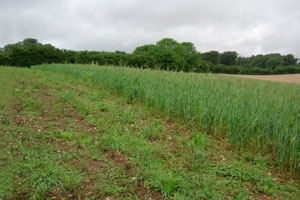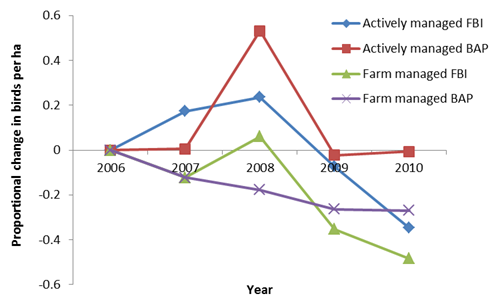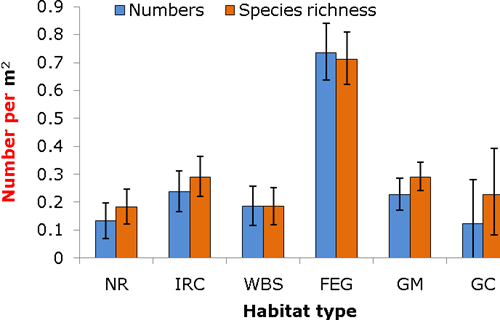 The widespread adoption of agri-environment schemes is seen as the best way to improve farmland biodiversity. Yet if this approach is to be applied efficiently and successfully we first need to know:
The widespread adoption of agri-environment schemes is seen as the best way to improve farmland biodiversity. Yet if this approach is to be applied efficiently and successfully we first need to know:
- Does active management (comparable to the HLS approach with advisory back up) compared to farm management (ELS approach without advice) lead to higher levels of biodiversity?
- Are there relationships between the proportion of uncropped land and levels of biodiversity and can thresholds be identified?
- How should this land be arranged in the landscape?
The Farm4Bio project was initiated to try to answer these fundamental questions. Seven approaches were compared that include farms with and without advice, 1.5 or 6ha of uncropped land in the 100ha study area, and actively managed uncropped land arranged in either several strips or 1-2 large blocks, giving the following treatments:
- 6 ha in strips actively managed
- 1.5 ha in strips actively managed
- 6 ha in blocks actively managed
- 1.5 ha in blocks actively managed
- 6 ha farm managed
- 1.5 ha farm managed
- Organic
Each treatment was trialled on four farms across southern England and East Anglia.
On the actively managed farms, four essential types of habitats were established adjacent to each other:
- Wild bird seed mixtures
- Insect-rich cover for foraging birds
- Floristically-enhanced grass to provide nectar and pollen
- Natural regeneration to encourage annual arable plants
On the farm-managed sites, the majority of uncropped land was grass margins, which is the most popular habitat created under ELS. On all the plots, we measured the abundance and diversity of plants, insects and birds.
We were able to detect relatively few effects of the different treatments. Beetles were encouraged by the actively managed habitats whereas spiders increased on farmer managed farms where there were more grass margins. More linnets were found on actively managed farms. In comparison to the national trend, the number of birds on the farmland bird index and Biodiversity Action Plan species were maintained on the actively managed farms, but declined on the farmer-managed farms. Weed diversity, hares and skylarks were greater or more numerous on organic farms.
Increasing the amount of uncropped land had positive effect on a broad range of taxa, including plants in field margins, butterfly diversity, wild bee abundance and diversity, and a weak positive effect on 16 farmland bird species (significant for three declining species). How the uncropped land was arranged had less impact, although linnets preferred large blocks and skylarks and butterflies favoured strips (possibly reflecting the territorial distribution of the larks’ relatively to the more gregarious linnets, as opposed to the arrangement of the habitat itself). We would still advise that insect-rich habitats are well distributed across farms in strips close to nesting sites, to maximise the number of bird territories that have access to the habitat and reduce the distance over which birds must forage.
Figure 1: Proportional change in number of BAP species and Farmland bird index birds relative to 2006 (baseline) adjusted according to national trend for farmer- and actively-managed farms. A value of 0 indicates no difference from national trend

The actively managed habitats supported almost three times as many chick-food insects. Looking more closely at the invertebrates in each habitat type revealed that floristically enhanced grass (FEG) supported over three times as many wild bees (bumble bees and solitary bees) and wild bee taxa compared to the other habitats in June and August. Hoverflies, whose larvae eat aphid pests, were twice as abundant in the FEG and grass margins compared to the other actively managed habitats and game cover.
The weight of key chick-food invertebrates was twice as high and there were up to 50% more parasitic wasps in actively managed habitats compared to grass margins. The grey partridge chick-food index only exceeded the level required to maintain a grey partridge population in the wild bird seed mixture. However, this habitat is only suitable if the vegetation at ground level is sufficiently open for foraging chicks. We believe it is the high weed levels within this habitat that is supporting the insects rather than the sown plants.
Figure 2: Number of wild bees and wild bee species in habitats (NR, IRC, WBS,FEG) on actively managed farms and most common farm managed habitats (GM, GC) in June. (NR=natural regeneration, IRC=insect-rich cover, WBS=wild bird seed, FEG=floristically enhanced grass, GM=grass margin, GC=game cover)

Our recommendation is that the current levels of uncropped land could support significantly more biodiversity if it were more positively managed, although for birds at least, the area of uncropped land should ideally be beyond 5%. Every farm should aim to provide flowers in summer and seeds in winter and the more the better.
The full report from the project and practical guidelines derived from the research are available from HGCA.
Acknowledgements
This project was sponsored by the Department for Environment, Food and Rural Affairs (Defra), through the Sustainable Arable LINK programme.
Our research partners were:
The industrial funders were:
Further reading
- Holland, J. M., Storkey, J., Lutman, P. J. W., Henderson, I. & Orson, J. (2013). Managing uncropped land in order to enhance biodiversity benefits of the arable farmed landscape: The Farm4bio project. Project Report No. 508. AHDB/HGCA.
- Henderson I.G., Holland J.M., Storkey J., Lutman P., Orson J., Simper J. (2012). Effects of the proportion and spatial arrangement of un-cropped land on breeding bird abundance in arable rotations. Journal of Applied Ecology 49, 883-891.
- Storkey J., BrooksD., Haughton A., Hawes C., Smith B.M., Holland J.M. (2013). Using functional traits to quantify the value of plant communities to invertebrate ecosystem service providers in arable landscapes. Journal of Ecology 101, 38-46.